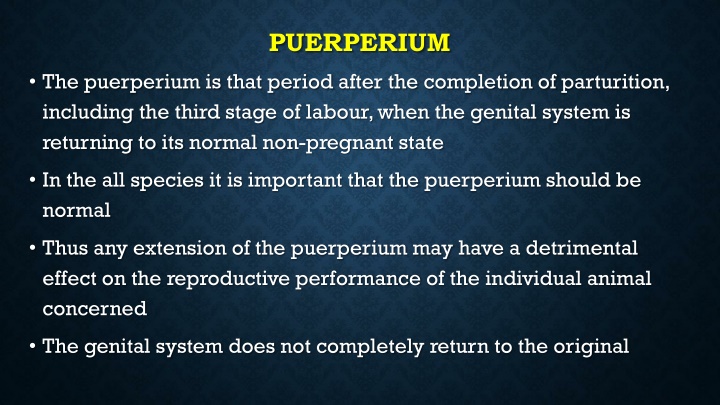
Puerperium and Uterine Involution Process
Learn about the puerperium period after childbirth and the essential process of uterine involution for a healthy postpartum recovery. Explore the activities involved, including myometrial contractions, ovarian function restoration, and bacterial elimination, to ensure optimal reproductive performance. Discover the timeline for uterine involution and its significance in different species like ewes, mares, and cows, as well as the role of prostaglandins in the process.
Download Presentation

Please find below an Image/Link to download the presentation.
The content on the website is provided AS IS for your information and personal use only. It may not be sold, licensed, or shared on other websites without obtaining consent from the author. If you encounter any issues during the download, it is possible that the publisher has removed the file from their server.
You are allowed to download the files provided on this website for personal or commercial use, subject to the condition that they are used lawfully. All files are the property of their respective owners.
The content on the website is provided AS IS for your information and personal use only. It may not be sold, licensed, or shared on other websites without obtaining consent from the author.
E N D
Presentation Transcript
PUERPERIUM The puerperium is that period after the completion of parturition, including the third stage of labour, when the genital system is returning to its normal non-pregnant state In the all species it is important that the puerperium should be normal Thus any extension of the puerperium may have a detrimental effect on the reproductive performance of the individual animal concerned The genital system does not completely return to the original
PUERPERIUM There are four main areas of activity: 1- The tubular genital tract, especially the uterus, is shrinking and atrophying as a result of tissue loss. Myometrial contractions, which continue for several days after parturition, aid this process and help in the voiding of fluids and tissue debris (involution)
PUERPERIUM There are four main areas of activity: 2- The structure of the endometrium and deeper layers of the uterine wall is restored 3- There is a resumption of normal ovarian function in poly-oestrous species and a return to cyclical activity 4- Bacterial contamination of the uterine lumen is eliminated
UTERINE INVOLUTION The reduction in the size of the genital tract is called involution Uterine contractions continue for several days After parturition the uterus size decrease to half Few involution between 4-9 days after parturition High involution between 10-14 day after parturition Real involution after 25-30 day fro parturition Complete involution is take 42-47 day
UTERINE INVOLUTION Uterine involution is occur as a result of shortening the muscle fiber after decreasing in the size of cells From 10 Kg after parturition to 0.7 in day 50th Uterine involution is followed by cervical involution After 24-36 a difficulties for passing hand from the cervix Two fingers after 4 days Complete cervical involution take 3 weeks
UTERINE INVOLUTION In ewes the uterine involution is take 30 day In mare is faster than cows ( so we can inseminate after 8-14 day from parturition) Clinically there is no any resumption to the actual size Prostaglandins play very important role for uterine involution
RESTORATION OF THE ENDOMETRIUM After the shedding of the allanto-chorion, the caruncle is about 70 mm long, 35 mm wide and 25 mm thick. Within the first 48 hours post-partum early necrotic changes in the caruncle The caruncular blood vessels become rapidly constricted and are nearly occluded At 5 days the necrosis has proceeded rapidly, Some of this necrotic material starts to slough and contributes to the lochia. Small blood vessels protrude from the surface of the caruncle causing a red coloration of the lochia
RESTORATION OF THE ENDOMETRIUM By 10 days, most of the necrotic caruncular tissue has sloughed and undergone some degree of liquefaction 15 days post-partum sloughing is complete, leaving only stubs of blood vessels protruding from the tissue surface A systemic response is observed due to the tissue damage and inflammation associated with the degenerative changes Regeneration of the epithelium of the endometrium occurs immediately after parturition in those areas and is complete in the inter-caruncular areas by 8 days.
RESTORATION OF THE ENDOMETRIUM Complete re-epithelialization of the caruncle is complete after 25- 30 day from parturition (histological puerperium) Involuted uterus is become histologically normal after 50-60 day from parturition
RETURN OF CYCLICAL ACTIVITY Decreasing in progesterone followed by increasing in the FSH High percentage of silent estrus and infertile occur after 13-15 day after parturition Occur again after 70-100 day Increasing in the cases of follicular and luteal cyst In mares the foal heat after 6-13 day after parturition Milking delay postpartum estrus Ewes take 2 month, while in dog the weaning play role for resumption the postpartum estrus
ELIMINATION OF BACTERIA Blood and necrotic tissues is a good media for bacteria The main mechanism involved in the elimination of the bacteria is phagocytosis by migrating leukocytes In addition, the phagocytes also release pro-inflammatory cytokines, such as tumour necrosis factor and interleukins, which stimulate the acute phase protein response uterine contractions and physical expulsion of the bacteria The role of estrogen in first estrus Uterine defense mechanism
LOCHIA Discharge after parturition usually start after day 3-4 fro parturition Volume Decreased after day 8 In day 14-18 disappear Is composed from blood, mucous, debris, necrotic tissues At first reddish brown, bloody, yellowish
